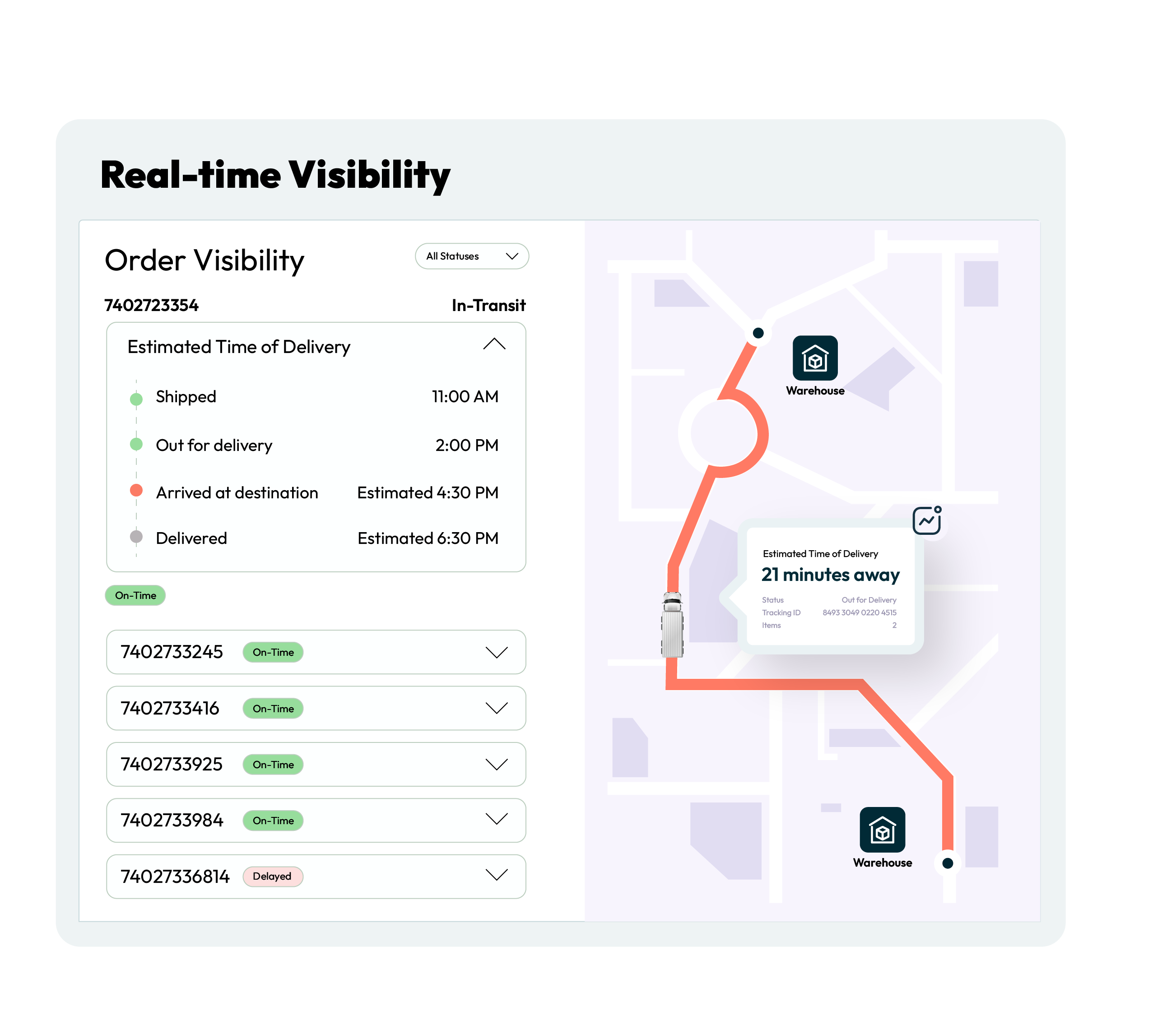- Dynamic Routing
Dynamic Routing and Its Impact on Reducing Last-Mile Delivery Costs
Table of Contents
- Understanding Dynamic Routing in Last-Mile Delivery
- Types of Dynamic Routing for Fleets
- Why Dynamic Routing Drives Cost Reduction
- How Real-time Dynamic Route Optimization Works
- The Business Value: Direct Results from Dynamic Routing
- Overcoming Modern Challenges with Dynamic Routing
- Implementation and Time-to-Value
- Operational Prerequisites and Common Pitfalls
- FarEye: Delivering the Future of Fleet Optimization
- Unlocking the Full Value of Dynamic Routing
- FAQs

There’s never been a greater focus on the last mile than right now. As retail and distribution continue their digital expansion, delivery costs have become a major battleground. The pressure is clear: consumers want fast, affordable, and predictable deliveries, but fuel, labor, and operational costs are rising sharply. Dynamic routing has therefore become a critical strategy for businesses seeking to balance rising costs with customer expectations
According to a report, global e-commerce sales are projected to exceed $5.89 trillion by 2029, with North America and China holding a significant share. With demand for doorstep delivery accelerating, cost management is no longer a back-office issue; it’s a boardroom priority. Success hinges on a company’s ability to optimize every mile, every stop, and every resource.

Understanding Dynamic Routing in Last-Mile Delivery
Dynamic routing stands at the core of modern fleet management strategies. Rather than relying on pre-set routes, dynamic routing involves continuous adjustment of delivery plans based on real-time information.
This method adapts to new orders, cancellations, road closures, weather, traffic, and vehicle availability as they happen. For logistics operations handling thousands of orders, this is the scalable path for high-volume operations.
Types of Dynamic Routing for Fleets
It’s important to understand the different types of dynamic routing solutions used in fleet management today. Each addresses specific operational demands and constraints.
- Real-time Dynamic Routing
This system updates routes instantly as conditions change, ensuring drivers avoid delays and reduce unnecessary detours. - Predictive Dynamic Routing
By analyzing historical data and trends, these algorithms anticipate disruptions and plan for the smoothest possible delivery flow. - Constraint-based Dynamic Routing
This approach factors in vehicle capacity, delivery windows, driver shifts, compliance regulations, and other business rules. - Event-driven Routing
Routes are adapted immediately when high-priority orders or last-minute cancellations occur.
Selecting the right type of dynamic routing or a combination is essential for any operation seeking to optimize last-mile costs and efficiency.
Why Dynamic Routing Drives Cost Reduction
Dynamic routing transforms cost structures by eliminating wasted time, distance, and labor. Here’s how it delivers real savings:
- Fewer Miles Driven and Lower Fuel Spend
When routes are continually optimized, drivers take the fastest, most direct paths, cutting out unnecessary mileage and detours. This directly reduces fuel expenses and wear on vehicles. - Improved Drop Density and Fleet Utilization
Dynamic routing allows each vehicle to make more stops per trip, raising productivity without increasing fleet size. Better route clustering means drivers deliver more packages with fewer resources. - Reduced Overtime and Labor Hours
As delays and disruptions are minimized, drivers spend less time on the road and less time waiting for route updates. Automated route adjustments replace manual rescheduling, so planners and dispatchers focus on value-added activities. - Fewer Failed Deliveries and Redeliveries
Route adjustments in real time mean missed windows and “not at home” scenarios are drastically reduced. This minimizes redelivery costs and keeps customer satisfaction high. - Asset and Resource Optimization
With smarter routes, companies often discover they need fewer vehicles to achieve the same delivery targets, freeing capital and reducing fixed costs.
How Real-time Dynamic Route Optimization Works
Real-time dynamic route optimization integrates data from telematics, GPS, weather services, and order management systems. As new information arrives, the routing engine recalculates optimal paths for every vehicle on the road.
- Instant Data Feeds
Orders, cancellations, traffic jams, and weather alerts feed directly into the system. - AI and Machine Learning
Algorithms analyze countless variables, location, time, capacity, and constraints, adjusting plans on the fly. - Automated Driver Updates
Revised routes are pushed directly to driver devices, so field teams are always working from the latest plan. - Visibility and Control
Dispatchers and supply chain managers monitor the entire operation on a single dashboard, with alerts for any delivery at risk of SLA breach.
This technology turns a traditional schedule into a living, responsive operation that adapts moment by moment.
The Business Value: Direct Results from Dynamic Routing
Organizations using real-time dynamic routing consistently report measurable improvements:
- Up to 40% reduction in route distances and planning times for high-volume parcel and truck deliveries.
- Reduction in load planning time from hours to minutes, with AI-driven automation replacing manual work.
- Double-digit increases in vehicle and driver productivity, as seen in large-scale implementations across parcel, truck, and big & bulky segments.
- Annual savings in the millions for enterprise fleets, thanks to reduced operational overhead and improved asset utilization.
- A significant drop in delivery costs of up to 46% for food and grocery routing, with in-house fleet optimization over aggregators.
These benefits are not just theoretical. They are validated by organizations that have adopted dynamic, AI-driven routing.
Overcoming Modern Challenges with Dynamic Routing
Today’s logistics leaders face a complex set of challenges: rising labor costs, fluctuating demand, tight delivery windows, regulatory compliance, and the need for sustainability. Dynamic routing addresses these head-on:
- High Delivery Costs: Route optimization slashes unnecessary miles and maximizes asset use.
- Capacity and Shift Utilization: Advanced algorithms align driver shifts, vehicle capacity, and delivery time slots for optimal scheduling.
- Operational Inefficiency: Automated planning replaces manual scheduling, shrinking idle time and driving up productivity.
- Congestion and Dynamic Changes: Real-time updates keep drivers ahead of traffic and weather disruptions, maintaining SLA adherence.
- Sustainability Goals: Efficient routing reduces emissions and supports green delivery initiatives.
Implementation and Time-to-Value
Rolling out dynamic routing doesn’t have to be disruptive. Most enterprises begin with a pilot project that integrates the routing engine with their existing order management and telematics systems. The data required typically includes delivery addresses, vehicle capacity, driver schedules, and traffic or weather feeds. Once connected, the system begins optimising routes in real time, with dashboards providing immediate visibility for planners and dispatchers.
The time-to-value is measured in weeks, not years. Organisations often see measurable results such as reduced mileage and improved fleet utilisation within 4 to 8 weeks of pilot deployment. With AI-driven automation replacing manual planning, ROI scales quickly as the solution expands across regions and fleet types.
Operational Prerequisites and Common Pitfalls
For dynamic routing to succeed, several operational factors need attention. Addressing these early helps avoid friction and ensures smoother adoption:
- Telemetry Quality: Accurate GPS and telematics data are essential for real-time updates.
- Geocoding Accuracy: Incorrect or incomplete location data can create inefficiencies.
- Constraint Configuration: Fleet rules, driver shifts, and compliance must be properly set up for realistic optimisation.
- Driver Adoption: Ensuring drivers are trained and trust the system is critical for execution in the field.
FarEye: Delivering the Future of Fleet Optimization
FarEye has emerged as a leading solution for enterprises looking to master the last mile. The platform leverages AI, machine learning, and real-time data to offer customized routing for every fleet type: parcel, LTL, FTL, food, grocery, and big & bulky. FarEye’s engine incorporates over 100 constraints, from driver skills and compliance to EV charging, geofences, and dynamic delivery windows.
Through its plug-and-play API, FarEye integrates with OMS, TMS, and WMS systems, generating optimized routes for thousands of orders in minutes. Features such as SMART Service Times, rate-based routing, and dynamic green window allocation enable businesses to reduce costs, boost capacity utilization, and deliver a best-in-class customer experience.
Case in Point:
- A global courier improved productivity by 15% and doubled driver satisfaction while reducing costs.
- A leading trucking firm cut planning time by 90%, saving over $1 million annually and reducing driving hours by 16%.
Unlocking the Full Value of Dynamic Routing
Dynamic routing is not simply a software feature; it is a shift in how logistics teams manage resources, serve customers, and control costs. By replacing manual planning with intelligent automation, organizations unlock new levels of efficiency and competitiveness.
With FarEye’s real-time dynamic routing platform, enterprises gain more than just operational speed; they achieve a scalable, resilient, and sustainable last-mile model that meets today’s business demands and tomorrow’s growth.
FAQs
- What is dynamic routing?
Dynamic routing is the continuous optimisation of delivery routes based on real-time data such as traffic, weather, order changes, and vehicle availability. It ensures faster, more efficient, and cost-effective last-mile operations. - Which types of dynamic routing are best for grocery vs. FTL?
Grocery fleets benefit most from real-time and event-driven routing due to frequent last-minute changes. FTL operations typically rely on constraint-based routing to factor in capacity, compliance, and time-sensitive delivery windows. - How long does it take to see ROI from dynamic routing?
Most organisations see measurable ROI within 4 to 8 weeks of pilot deployment, as optimised routes reduce mileage, planning hours, and labour costs. - What data is required to implement dynamic routing?
Key inputs include delivery addresses, driver schedules, vehicle capacities, traffic data, and weather feeds. Accurate geocoding and telemetry are critical for successful implementation. - What is dynamic routing and how does it differ from static routing?
Dynamic routing adapts delivery routes in real time using live data such as traffic, weather, and order changes. Static routing, by contrast, relies on pre-set routes that cannot adjust to disruptions. - What are the main types of dynamic routing and when should each be used?
Real-time routing is best for grocery or parcel fleets with constant order changes. Predictive routing suits seasonal or high-volume patterns. Constraint-based routing is ideal for FTL or regulated industries, while event-driven routing is effective when handling urgent or cancelled orders. - How quickly can my fleet see savings from dynamic routing?
Most fleets begin seeing measurable cost savings and efficiency gains within 4 to 8 weeks of a pilot deployment. - What data do I need to enable real-time dynamic routing?
The core requirements are accurate delivery addresses, fleet and driver schedules, vehicle capacity data, and reliable telematics or GPS feeds. Supplementary inputs like traffic and weather data improve accuracy further.
Source:

Komal Puri is a seasoned professional in the logistics and supply chain industry. As the AVP of Marketing and a subject matter expert at FarEye, she has been instrumental in shaping the industry narrative for the past decade. Her expertise and insights have earned her numerous awards and recognition. Komal’s writings reflect her deep understanding of the industry, offering valuable insights and thought leadership.
Let's Talk to Our Experts and Optimize Your Deliveries Today!
An expert from our team will reach out within 24 hours


